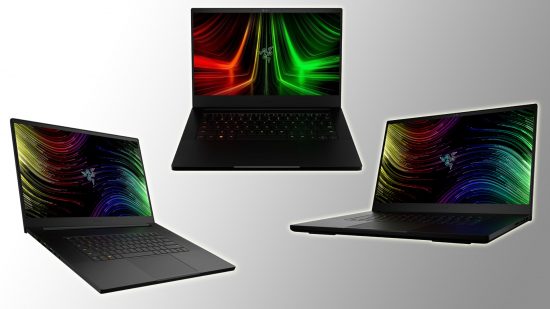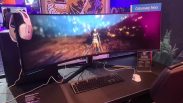There’s a good reason that the best Razer laptops are coveted by so many gamers and creators. Razer has been known for its high-quality, premium machines for almost two decades now, and has elevated the best gaming laptop space into something arguably more grown-up.
Razer’s thin and light laptops are bristling with high-end components ranging from the 3060, up to the beastly 4090 graphics cards in the Razer Blade 18. With 14, 15, 16, 17 and 18-inch models on offer, there are plenty of best Razer laptops to choose from, and we’re here to point you in the right direction. When shopping for a Razer laptop, you’re going to see sizeable reductions in models from the previous year, especially seeing as we have moved onto the RTX 4000 series of cards.
The top end of the Razer lineup is costly, but we’ve included it here because some will need or want it, and the rest of us mere mortals can gawk at its spec sheet. Razer laptops traditionally trade a bit of power for portability as their cooling solutions have to be slimmer to fit into their diminutive chassis. The gap has narrowed a little with the massive efficiency games made by the Nvidia 4000 cards, though.
We’ve collated a list of the best Razer laptops for gaming with options for everyone, be it for esports aficionados, ray-tracing fanatics, those needing the most portable solution or players someone after the best value option.
The best Razer laptops for gaming are:
- Razer Blade 16 4080 – best choice for most
- Razer Blade 18 – best desktop replacement
- Razer Blade 15 FHD 360Hz – top esports Razer laptop
- Razer Blade 16 4070 – best midrange Razer laptop
- Razer Blade 17 – best 17-inch machine
- Razer Blade 14 – best compact Razer laptop
- Razer Blade 15 Base – best budget Razer laptop
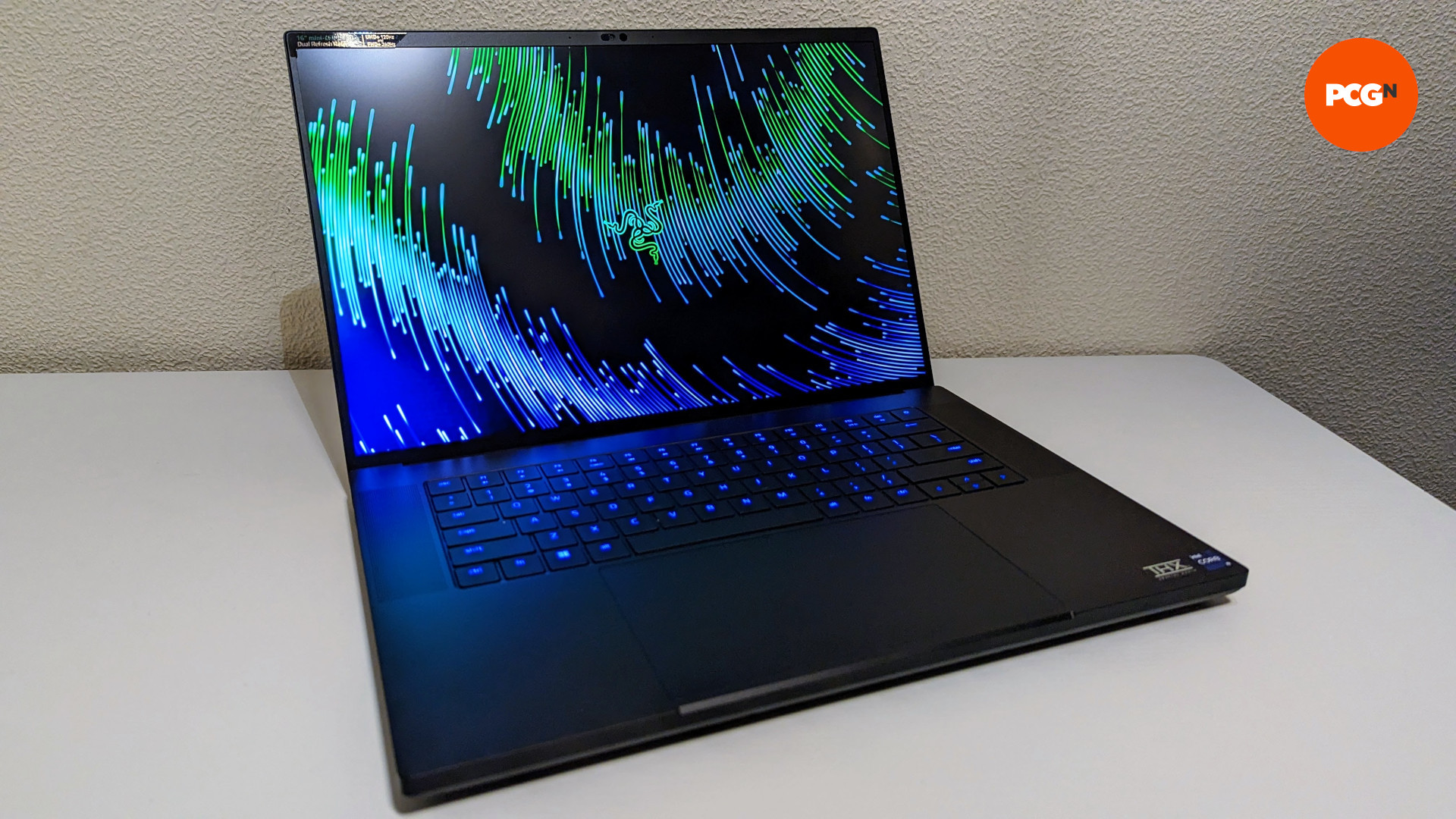
1. Razer Blade 16
Best overall Razer Gaming laptop.
Razer Blade 16 specs:
| Graphics | Nvidia RTX 4080 12GB GDDR6 |
| CPU | Intel i9-13950HX 24 Cores 5.5Ghz |
| RAM | 32GB DDR5-5600MHz |
| Storage | 1TB SSD (M.2 NVMe PCIe 4.0 x4) |
| Ports | Thunderbolt 4 USB-C, 1 USB-C 3.2 Gen 2, 3 USB-A 3.2 Gen 2, HDMI 2.1 out UH-II SD Card Reader, Gigabit Ethernet |
| Screen | 16″ QHD+ 240 Hz, 16:10 (2560 x 1600 WQXGA) |
| Dimensions | 21.99 mm x 244 mm x 355 mm |
| Weight | 5.40 lbs (2.45 kg) |
Pros:
- Plenty of power
- Sleek design
- 16:10 display
Cons:
- Expensive
We searched high and low for the best Razer laptop to suit most players and budgets, and we arrived at the Razer Blade 16. It’s equipped with Nvidia’s RTX 4080, which pairs excellently with the new 16” QHD+ 240Hz display with a 16:10 aspect ratio.
This extra space is great for games and productivity alike and we will gladly accept black bars when watching YouTube as otherwise for the rest of the time it would just be plastic anyway. We’ve opted for the 4080 model here as this ensures you won’t run into any VRAM snafus as some of the latest triple-A titles have had issues with 8GB GPUs.
The 4080 also brings DLSS 3 with it ensuring that you’ll be able to make full use of 240Hz refresh rate in the games that support it. Older titles will have no issue at all reaching these high framerates as the 4080 is a graphical powerhouse.
The Intel i9-13950HX and its 24 cores will chomp through any task thrown its way and will especially sing in CPU-bound tasks such as compiling code.
The 32GB of RAM will ensure dutiful service for many years to come and what’s more – the RAM is entirely user replaceable so if you need to have 1000 Chrome tabs open you can easily slot in some new sticks without much hassle at all.
The 1TB SSD should offer plenty of storage but if you are a power user then rest assured this can also be swapped out for a higher capacity drive and there’s even an additional M.2 slot if you really want to go crazy.
This all comes at a cost however as the Blade 16 4080 has an MSRP of $3,599.99 (£3,599.99) so you may find better value elsewhere in laptops that are chunkier and use more plastics.
Read our Razer Blade 16 (2023) review.
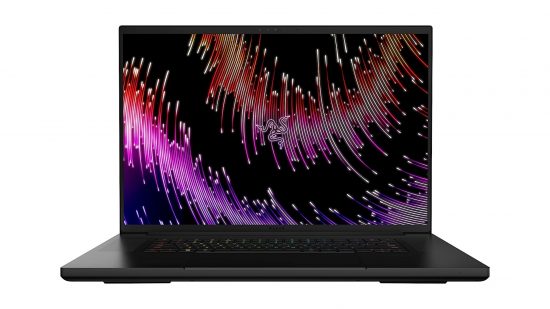
2. Razer Blade 18
Most powerful Razer gaming laptop.
Razer Blade 18 specs:
| Graphics | Nvidia RTX 4090 (16GB GDDR6 VRAM) |
| CPU | Intel i9-13980HX 24 Cores 5.6Ghz |
| RAM | 64 GB DDR5-5200MHz |
| Storage | 2 TB SSD (M.2 NVMe PCIe 4.0 x4) |
| Ports | Thunderbolt 4 (USB-C) port, 1 USB-C 3.2 Gen 2 port, HDMI 2.1 out port, UH-II SD Card Reader, Gigabit Ethernet |
| Screen | 18″ QHD+ 240 Hz, 16:10 (2560 x 1600) |
| Dimensions | 21.90mm x 275.40mm x 399.90mm |
| Weight | 6.80 lbs (3.10 kg) |
Pros:
- About as powerful as a laptop can be
- Huge display
- Plenty of VRAM
Cons:
- Not as portable
- Even more expensive
- No numpad
The 4090 will make short work of any game or application you put through it and currently – only a handful of titles will need DLSS 3 given how powerful the system is. DLSS 3 does offer a lot in the way of futureproofing however and with Unreal Engine 5 about to be unleashed upon us mere mortals – we’ll be glad to have this future as games get even more demanding.
With 16GB of VRAM – you shouldn’t have any issues for a long while yet short of any broken games. This is equally useful for games as it is applications such as Adobe Premier and the like so if you need a lot of it – you can’t do any better in a mobile form-factor.
The 18” QHD+ display will offer plenty of space for games and programs alike and similarly to the Blade 16, the display has a 16:10 aspect ratio so there is absolutely no wasted space.
Despite its size, the Blade 18 curiously doesn’t have a numpad which is commonplace amongst other 17 and 18-inch laptops. Being 18 inches, you can bet that it’s not the most nimble laptop to take with you on the go but that said – it’s easily the most portable 18-inch laptop out there.
The elephant in the room (other than this 18 ich behemoth) is that this spec of Blade 18 costs a lot. It has an MSRP of $4,999.99 (£5,199.99) so unless you have deep pockets or can claim it against your taxes then you might find better value elsewhere.
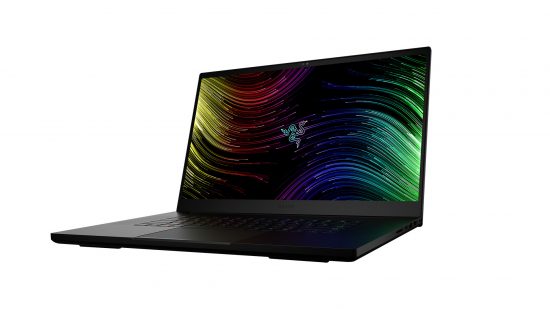
3. Razer Blade 15 FHD 360Hz
Best Razer gaming laptop for esports.
Razer Blade 15 FHD 360Hz specs:
| Graphics | Nvidia RTX 3070 Ti 8GB GDDR6 |
| CPU | Intel i7-12800H 14 Core 4.8Ghz |
| RAM | 16 GB DDR5 4800 MHz |
| Storage | 1TB SSD (M.2 NVMe PCIe 4.0 x4) |
| Ports | Thunderbolt 4 USB-C port, 2 x USB-C 3.2 Gen 2 ports, 3 x USB-A 3.2 Gen 2 ports, UHS-II SD Card Reader, HDMI 2.1 out port |
| Screen | 15.6″ FHD 360Hz, 16:9 (1920 x 1080) |
| Dimensions | 16.99 mm x 235 mm x 355 mm |
| Weight | 4.40 lbs (2.01 kg) |
Pros:
- Fast 360Hz panel
- Great GPU for esports
- Great value when discounted
Cons:
- Not 16:10
- 1080p
Esports titles demand that players have high refresh rates to command an edge over others and the Razer Blade 15 FHD 360Hz has this in spades with the fastest panel Razer still has on offer.
Esports titles such as Counter-Strike, Apex Legends and Valorant are very well optimized, so the 3070 Ti will absolutely sing and keep the panel fed with hundreds of frames. Nvidia Reflex will also help keep your latency down for those crucial flickshots.
To keep up with the GPU is the Intel i7-12800H which should offer plenty of power to ensure you don’t become CPU bound if you like to crank the settings down for maximum frames. It also won’t break a sweat when you compile your compilation of best AWP shots down mid on Inferno either.
There is a bit of wasted space at the bottom of the screen seeing as it is a 16:9 panel as opposed to the latest generation of blades but the high-refresh rate is what we’re after here so this is more than excusable.
At 1080p, you might struggle a little to parse some details in the distance but again it’s the frames that are important here. It’s definitely something worth considering though and you may be better served with a 240Hz panel that is QHD – especially if you employ a gamer lean and have your nose pressed up against the screen.
Though its MSRP is $2,999.99 (£3,099.99), it has been discounted for quite some time now and has been seen listed down to $1,799.99 (£1,699.99) which is a great value proposition for a brand new Razer laptop.
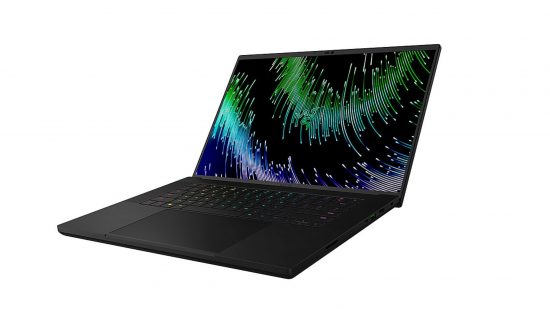
4. Razer Blade 16 4070
Best midrange Razer gaming laptop.
Razer Blade 16 4070 specs:
| Graphics | Nvidia RTX 4070 8GB GDDR6 140W |
| CPU | Intel i9-13950HX 24 Core 5.5Ghz |
| RAM | 16 GB DDR5-5600MHz |
| Storage | 1 TB SSD (M.2 NVMe PCIe 4.0 x4) |
| Ports | Thunderbolt 4 port, USB-C 3.2 Gen 2, 3 USB-A 3.2 Gen 2, 1 HDMI 2.1 out, UHS-II SD Card Reader |
| Screen | 16” QHD+ 240Hz (2560 x 1600) |
| Dimensions | 35.5 x 24.4 x 2.2cm |
| Weight | 5.40 lbs (2.45kg) |
Pros:
- Better price-to-performance value
- Upgradeable RAM and storage
Cons:
- VRAM limitations
- Older models have more VRAM
If you want the taller display but don’t need the full power of the RTX 4080, the Razer Blade 16 with the RTX 4070 should serve you very well. Make no mistake, the 4070 is still a very capable card and will provide years of valuable service seeing as more and more titles are adopting technologies such as DLSS 2 and DLSS 3, the latter coming especially in clutch in CPU bound titles and the Crysis’ of the future come out.
We really cannot gush enough about how transformative 16:10 aspect ratio displays are, so we are going to again – it is truly unbelievable how much bigger a display feels when it fills in the bottom chin and lets you see more of everything, be it a sniper on the roof or extra rows of code.
The 4070 only has 8GB of VRAM available to it, which is a downside for running games that are either unoptimized. With the aforementioned DLSS and optimized settings, this laptop should see you through at least a few years of play, but it is certainly worth considering.
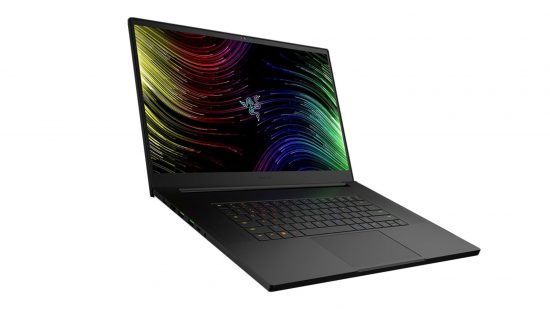
5. Razer Blade 17
Best 17-inch Razer gaming laptop.
Razer Blade 17 specs:
| Graphics | Nvidia RTX 3070 Ti 8GB GDDR6 150W |
| CPU | Intel i9-12900H 14 Core 5.0Ghz |
| RAM | 16 GB DDR5 4800 MHz |
| Storage | 1TB SSD (M.2 NVMe PCIe 4.0 x4) |
| Ports | 2 x Thunderbolt 4 USB-C, 3 USB-C 3.2 Gen 2, RJ45 ethernet, HDMI 2.1 out, 3.5mm combo, UHS-II SD Card Reader |
| Screen | 17.3″ QHD 240Hz, 16:9 (2560 x 1440) |
| Dimensions | 39.5 x 26 x 2 cm |
| Weight | 5.50 lbs (2.50 kg) |
Pros:
- Still powerful
- More affordable
Cons:
- No 16:10 display
- Last gen
In the realm of reason, great deals can be had and the Razer Blade 17 is a good option for those who need extra screen real estate without entirely breaking the bank.
Games and text alike will look crisp and sharp on the QHD panel with beautifully smooth motion owing to the 240Hz refresh rate.
Though not our absolute top pick for esports, the Blade 17 will shine here too as the 3070 Ti will easily max out the display with the right settings and while it may not do so in the latest demanding titles, G-Sync will save the day and shield us from any screen-tearing no matter the refresh rate.
Being larger than its siblings – the Blade 17 has an absolute plethora of useful ports on offer such as the two Thunderbolt 4 ports which provide Display Port functionality allowing for multiple displays for immersive gaming or massive productivity potential.
Being last-gen though we have to make do with some concessions such as the 16:9 screen meaning we will have a plastic chin under our display – though at 17 inches there is still plenty of space.
The 3070 Ti also isn’t able to make use of DLSS 3 frame generation but DLSS 2 should keep you going for a good few years to come – especially when paired with sensible optimized settings. The Razer Blade 17 has been seen as low as $2,699.99 (£2,599.99) which is a bargain for a Blade of this caliber.
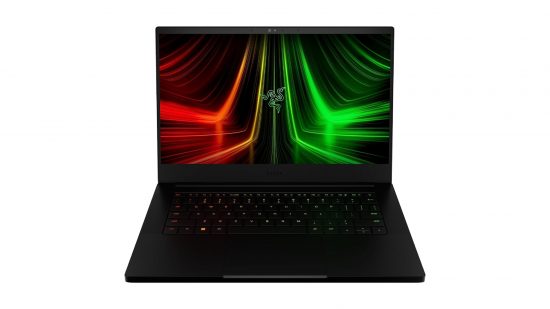
6. Razer Blade 14
Best compact Razer gaming laptop.
Razer Blade 14 specs:
| Graphics | Nvidia RTX 3080 Ti 16GB GDDR6 |
| CPU | AMD Ryzen 9 6900HX 8 Core |
| RAM | 16 GB DDR5-4800 MHz |
| Storage | 1TB SSD (M.2 NVMe PCIe 4.0 x4) |
| Ports | 2 x USB 3.2 Gen 2 x Type-A, 2 xUSB 4 Type-C with DisplayPort, HDMI 2.1 out |
| Screen | 14” QHD 165Hz (2560 x 1440) |
| Dimensions | 16.8 mm x 220 mm x 319.7 mm |
| Weight | 3.92 lbs (1.78 kg) |
Pros:
- Powerful despite its small form factor
- Great value
- Efficient iGPU
Cons:
- Last gen device
The Razer Blade 14 is a pocket rocket, equipped with up to a whopping 3080 Ti. The version we have included here will be future-proofed for many years to come, owing to the graphical performance of the card and the 16GB of VRAM – which is only seen in the 4090 elsewhere in the Nvidia mobile stack.
The AMD Ryzen 6900HX is a beat of a CPU, which can chew through almost anything you throw at it, especially multithreaded tasks which Ryzen CPUs have been known to excel at for years now. The 6900HX also has a very capable iGPU in the form of the AMD Radeon 680M which is more powerful than what the Steam Deck offers. Whilst you might not be playing Cyperbunk 2077 with Overdrive ray tracing, it’s very handy for when you want to play some lighter or older games away from the wall or just to save on the energy bill.
The 680M is more than enough to power the display when watching YouTube and doing tasks such as light photo editing too so battery life is very good for a gaming laptop.
The dreaded 16:9 aspect ratio rears its ugly head and given the smaller screen, the chin effect is more pronounced here. The latest generation of the Blade 14 does have a 16:10 display but it is much more expensive and only tops out at a 4070 which only has 8GB of VRAM.
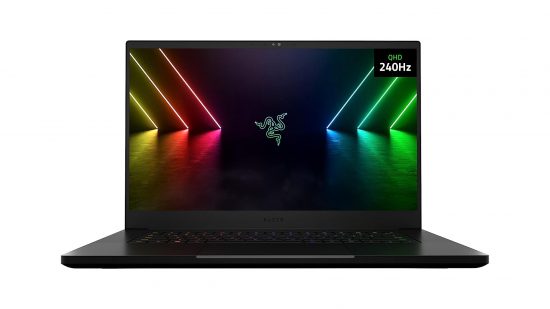
7. Razer Blade Base 15 3060
Best budget Razer gaming laptop.
Razer Blade Base 15 3060 specs:
| Graphics | NVIDIA GeForce RTX 3060 6GB GDDR6 |
| CPU | Intel i7-12800H 14 Core 4.8Ghz |
| RAM | 16 GB DDR5 4800 MHz |
| Storage | 1TB SSD (M.2 NVMe PCIe 4.0 x4) |
| Connectivity | 3 x USB-A 3.2 Gen 2, 2 x Thunderbolt 4, HDMI 2.1 out, UHS-II SD Card Reader, 3.5mm combo jack |
| Screen | 15.6” QHD 240Hz (2560 x 1440) |
| Dimensions | 35.5 x 23.5 x 1.7cm |
| Weight | 4.40 lbs (2.01kg) |
Pros:
- Cheapest option
- Respectable performance
Cons:
- VRAM limitations at 1440P
- Not as future proof
The Razer Blade Base 15 is proving to be a great value option now that they have been coming down in price in the wake of the new generation of Blade’s. The RTX 3060 is still a capable little card if you get your settings dialed in, and will serve you extremely well if you stick to older games or well-optimized esports titles.
The QHD 240Hz display and G-Sync ensure that games are running smoothly, while the DLSS 2 helps to eke out more performance as more demanding titles release. CPU-wise, the i7-12800H is a reasonable inclusion at this price point. If you’re after a CPU performance champ for work and only want to play a few games in the evening then the balance between the 12800H and 3060 is ideal.
To increase the longevity of the Razer Blade Base 15 3060, you can upgrade the ram up to 64GB to help draw out some extra performance too. One point of concern though is the 6GB of VRAM, and how viable it is at 1440P long-term. With DLSS, this is less of a problem, but soon you might feel like you are running out of performance.
How we chose the best Razer gaming laptops
When deciding which models to include in this list, we considered the following factors:
- Pricing: Prices vary enormously depending on what you need your laptop to do. We included a range of options to accommodate different needs and budgets.
- Sustainability: Is a model future-proof? Will it continue to update and be usable for the foreseeable future? Are they using CPUs and GPUs that modern games work with? We only wanted to keep up-to-date options on this list.
- RAM: We’ve not got anything on this list with less than 16GB. Obviously, you can find models which are a lot better than that, but we thought this would be a good baseline for reasonable performance.
- Screen size: This is a big one for some gamers. A big screen will be especially important for gamers who play a lot of grand strategy games that have a lot of information on screen at all times.
- Storage space: Got a large library of games that you want to keep on your gaming laptop? Well, we’ve included some options with loads of space for you.
Read our how we test page for more information about the process that goes into making these lists. If you have more questions, please read the FAQs below:
What’s the newest Razer laptop?
The newest Razer laptop is the Razer Blade 14 which was released on June 20, 2023. This svelte little machine can pack up to an Nvidia RTX 4070 with a Ryzen 9 7940HS, can be upgraded to have up to 64Gb of RAM and makes use of every last bit of space with a 16:10 display so despite its size.
Is Razer better than Alienware?
Razer is better if you need a machine that is lower-key and can blend in at work or in a cafe. Razer laptops are typically lighter, too, and as such are more portable.
Alienware laptops lean much more into the gamer aesthetic. They are typically thicker and less portable, but this comes with the added benefit of having more room for cooling meaning you get more performance from your components.
Ultimately, one is neither better than the other and it’s more up to your sensibilities that will be the deciding factor when it comes to making a final decision on what laptop you want to go for.
Why is Razer a good gaming laptop brand?
Razer has been in the business since 2005 making gaming peripherals, and since 2011, the company has routinely set new industry standards for gaming laptops in a similar way that Apple has done over the years.
Razer was arguably the first company to make a truly portable and slim gaming laptop. Laptops are made with premium materials and are among the best when it comes to fit and finish. Razer also has a huge ecosystem of peripherals, making it possible to get a uniform look with a Razer gaming mouse, keyboard, headphones, and monitor, too.
For more help choosing the right gaming laptop, read out guides on the best Asus gaming laptops, and the best Dell gaming laptops. We’ve got a number of recommendations for you.
